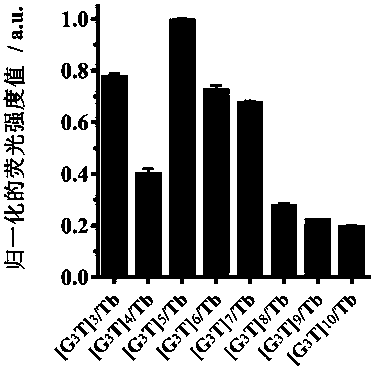Fluorescent sensor formed on the basis of DNA combining terbium ion, and application thereof for distinguishing and detecting metal ions
A technology of fluorescence sensor and metal ion, which is applied in the field of fluorescence analysis and detection, can solve the problems of in-situ real-time high-throughput rapid detection, inability to distinguish detection on a large scale, unfavorable large-scale promotion, etc., and achieve the elimination of background fluorescence and scattered fluorescence , low cost, and the effect of saving usage
- Summary
- Abstract
- Description
- Claims
- Application Information
AI Technical Summary
Problems solved by technology
Method used
Image
Examples
Embodiment 1
[0035] Screened from 10 sections of DNA of different lengths, the 10μM [G 3 T] N (N=1-10) (as shown in Table 1) were added to 10 μM Tb solution and incubated for 10 min, and detected by time-resolved fluorescence analysis. like figure 2 As shown, [G 3 T] 3 , [G 3 T] 5 and [G 3 T] 6 exhibited better sensitization capabilities. These three pieces of DNA were selected as antenna ligands to sensitize Tb to form a fluorescent sensor DNA / Tb, and then the stoichiometric ratio between DNA and Tb was explored, and different concentrations of DNA ([G 3 T] 3 , [G 3 T] 5 and [G 3 T] 6 ) were added to 10 μM Tb solution to obtain different concentrations of DNA-sensitized Tb, and after incubation for 10 min, time-resolved fluorescence analysis was used for detection. see results image 3 . like image 3 As shown, [G 3 T] 3 , [G 3 T] 5 and [G 3 T] 6 Antenna sensitization ratio ([G 3 T] N / Tb) are 4:5, 2:5, 1:5 respectively. Unless otherwise specified, in the follow...
Embodiment 2
[0039] Select silver ions (Ag) and chromium ions (Cr) and blank (water) as pre-experiments, take 10 μL of different metal ion solutions to be tested, add them to the sensor solution, mix and place at room temperature for 5 minutes, and then use the method of time-resolved fluorescence analysis to test. Use the method of principal component analysis to realize the processing of fluorescence data, such as Figure 4 As shown in a-e, Ag will enhance DNA / Tb fluorescence, while Cr will cause DNA / Tb fluorescence quenching. Each group of experiments was repeated 5 times, and the fluorescence matrix was analyzed by PCA method (3DNA / Tb sensor composition × target number × 5 parallel samples), and the results were as follows Figure 4 As shown in f, these three targets (2 metals and blank) can be distinguished by the fluorescence-based sensor DNA / Tb. In order to further explore the mechanism of action, the fluorescence lifetime of DNA / Tb in these three cases was measured, as Figure 4...
Embodiment 3
[0041] In order to evaluate the discrimination ability of DNA / Tb fluorescent sensor more widely, 49 kinds of metal ions were added as targets, including alkali metals, alkaline earth metals, transition / post-transition metals and rare earth metals, and their most common or stable states were selected. Since alkali metals have a lower charge density, they are difficult to detect and distinguish by fluorescence methods, so higher concentrations are chosen. The concentration of alkali metal is 500 μM, and the concentration of other metals is 5 μM, respectively added to three DNA / Tb fluorescent sensing elements, and the detection method is as described in the above pre-experiment. The PCA analysis method was used to evaluate the metal ion-induced DNA / Tb fluorescent sensor response. like Image 6 As shown in a,c,e,f, 5 alkali metals, 4 alkaline earth metals, 24 transition / post-transition metals, and 16 rare earth metals can be clearly distinguished with high discrimination accuracy...
PUM
 Login to View More
Login to View More Abstract
Description
Claims
Application Information
 Login to View More
Login to View More - R&D
- Intellectual Property
- Life Sciences
- Materials
- Tech Scout
- Unparalleled Data Quality
- Higher Quality Content
- 60% Fewer Hallucinations
Browse by: Latest US Patents, China's latest patents, Technical Efficacy Thesaurus, Application Domain, Technology Topic, Popular Technical Reports.
© 2025 PatSnap. All rights reserved.Legal|Privacy policy|Modern Slavery Act Transparency Statement|Sitemap|About US| Contact US: help@patsnap.com



